If you like to sew, you probably own a pincushion, needle book, or small caddy stocked with needles in all different shapes and sizes. But when you sit down to darn a sock or embroidery a dress, how do you know which needle to use? Check out this handy guide to the types of hand-sewing needles to find out!
Hand-sewing needles have varying lengths, diameters, and shapes based on the type of sewing they perform, such as crewel work or mending. These needles also have a sizing system in which larger numbers indicate a smaller diameter for the needle. The sewing type, fabric, and thread or ribbon used will determine which needle works best for a particular project.
In this article, you will find out how to identify a hand-sewing needle. You will discover the 18 most popular types of hand-sewing needles and learn what to use them for. Finally, you will find tips on how to pick the best hand-sewing needle for a beginner.
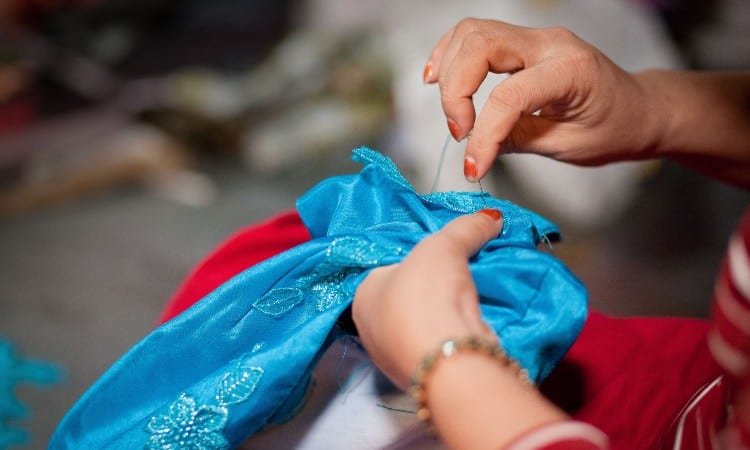
What are Hand-Sewing Needles?
Hand-sewing needles are a simple tool that allows you to manually stitch two or more pieces of material together. Hand-sewing needles have a point, a shaft, and an eye to hold thread, ribbon, or another binding element.
These needles look quite different from sewing machine needles. In a hand-sewing needle, the eye lies at the opposite end of the needle from the point. In a machine needle, the eye rests just above the point.
People have used hand-sewing needles since the earliest humans discovered animal skins and textile clothing, though the original needles featured carved bone or wood. Today, hand needles almost always contain carbon steel with a special rust-resistant coating of either gold or nickel.
You may wonder why people still sew by hand when sewing machines and factories make so much of our clothing today. But actually, hand-sewing needles still have dozens of useful purposes today!
Popular Uses of Hand-Sewing Needles
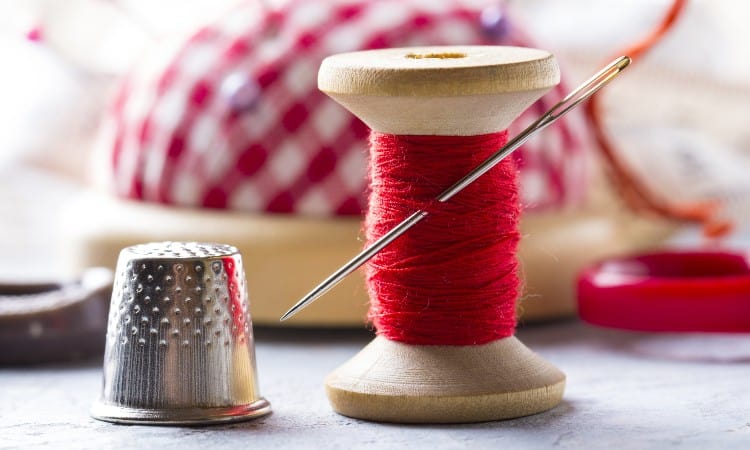
Popular uses of hand-sewing needles include mending, embroidery, tiny projects, and 3D projects like upholstery.
Even in this modern world where pretty much everything comes from a factory, some projects still work best when done by hand instead of on a sewing machine.
Several types of needles, like Sashiko needles and darning needles, have special shapes that make them perfect tools for mending holes in clothing.
Other needles have curved, heavy-duty shapes for bending around the corners of a chair and finishing an upholstery project.
And, of course, you can find many different kinds of embroidery and beading needles for decorative sewing! Crewel needles have larger eyes to hold crewel yarn, for instance. Beading neeles sometimes have a wire-thin form to allow them to slip through small beads.
You will often encounter a tiny sewing project that is easier to accomplish with the appropriate hand needles. If you like to make dolls, you may find that a fine doll needle is the only way to make invisible stitches to attach a doll’s hand or head to her body.
Finally, everyday tasks like sewing on a missing button just take less time with a hand needle.
How Do I Identify a Needle?
You can identify the purpose of a needle by examining its size, the shape of its eye, its length, and the style of its point.
Needles come in a huge range of sizes or diameters. This measures the widest portion of the shaft of the needle. This rather confusing sizing method uses bigger numbers to describe smaller needles, though–you can read more about needle sizing later in this article!
The shape of the eye often indicates what type of thread or string the needle fits best. Some needles have wide, flat eyes to allow you to thread a piece of ribbon. Others have tiny pinprick holes that you can barely see without a magnifying glass meant to hold beading wire.
As a general rule of thumb, the eye should contain 30% to 40% more space than the diameter of the thread you want to use. This way, the thread will not scrape against the eye and constantly break as you sew.
Needles also come in many different lengths. Shorter needles work well for thin, fine materials. Longer needles often work best for thicker material. Sometimes a longer needle also provides more flexibility, as in the case of doll and beading needles.
Lastly, one of the most crucial parts of a hand-sewing needle is its point. Needles can have many different styles of points, ranging from the familiar sharp point to a rounded ballpoint tip. Some specialty types, like tapestry needles, even have flared diamond-shaped points!
Each type of point works best for a particular material or a certain type of sewing. For example, a ballpoint needle can slide through the yarns in a piece of cloth without snagging on them. A sharp needle can break through a tightly woven piece of fabric.
Understanding the size, length, type of eye, and type of point in a needle will help you classify it into one of the eighteen most popular types of hand-sewing needles, as you will see in the next section!
18 Types of Hand-Sewing Needles
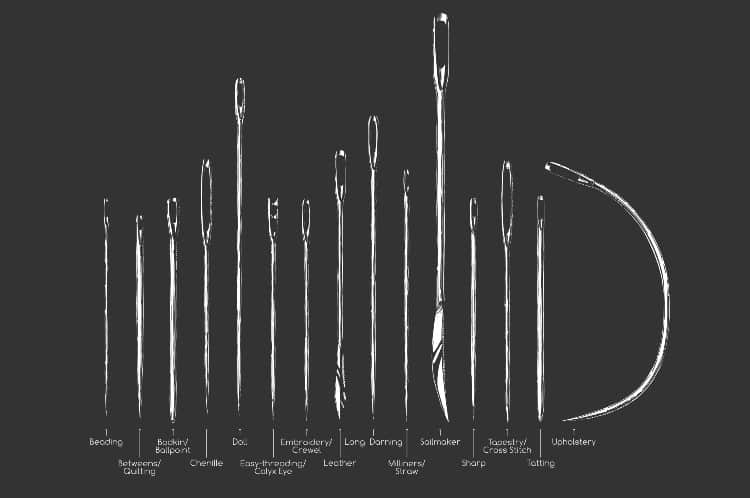
Check out this guide to find out what each of the 18 most popular types of hand-sewing needles looks like and what to use it for.
How many types of sewing needles are there? This depends on how much you want to subcategorize kinds of needles. In this guide, you will see the 18 most-used kinds of hand needles. That said, you could divide these types even further and list even more specific types of needles within each category.
The main thing to keep in mind is that you generally classify needles based on the kind of sewing they work best for.
1. Ball Point
 Ballpoint needles have a blunt, rounded tip that looks a lot like the tip of a ballpoint pen. This kind of needle can poke through knitted fabrics without catching on the fine, stretchy threads and breaking them. Ballpoint needles also work well for some types of embroidery, like cross stitch.
Ballpoint needles have a blunt, rounded tip that looks a lot like the tip of a ballpoint pen. This kind of needle can poke through knitted fabrics without catching on the fine, stretchy threads and breaking them. Ballpoint needles also work well for some types of embroidery, like cross stitch.
Ballpoint hand needles usually come in sizes 5 to 10 and have eyes wide enough to fit embroidery floss.
2. Beading
 Beading needles have a thin, flexible shape so fine that they can pass through seed beads. They come in various lengths and sizes, though you can expect this style to always have a thin and flexible shaft. Some popular beading needles include Japanese, English, big eye, and twisted beading needles.
Beading needles have a thin, flexible shape so fine that they can pass through seed beads. They come in various lengths and sizes, though you can expect this style to always have a thin and flexible shaft. Some popular beading needles include Japanese, English, big eye, and twisted beading needles.
You can use beading needles for jewelry-making, bead weaving on a loom, or embroidery featuring a beaded design. Threading some beading needles gets tricky because of the fine, tiny eyes. You may need to use jewelry pliers to flatten your beading wire or stiffen your beading thread before passing it through the eye.
3. Bodkins
 Bodkins may sound like an old-fashioned term right out of Shakespeare, but this long, thick style of needles has many modern uses. It can have a sharp or rounded tip and sometimes features an elongated or a double eye.
Bodkins may sound like an old-fashioned term right out of Shakespeare, but this long, thick style of needles has many modern uses. It can have a sharp or rounded tip and sometimes features an elongated or a double eye.
You use a bodkin primarily to get a length of cord or elastic through a fabric casing. For example, if you sewed a hoodie, you could use a bodkin to get the drawstring into the casing around the hood.
4. Crewel
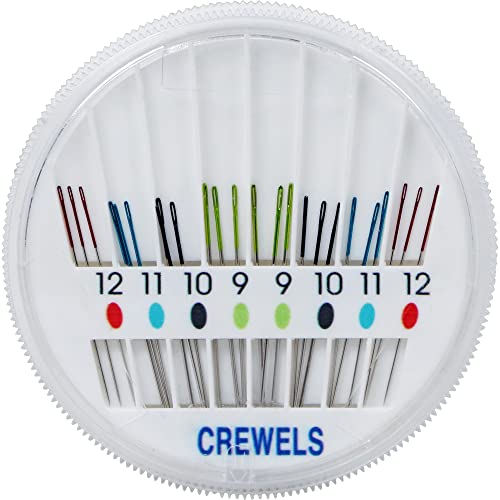 A crewel needle has an extra-long eye, so you can easily fit the fine yarns used for crewel embroidery into it and a sharp point. This type of needle can come in several lengths and sizes, but it always features that classic long eye. You also sometimes see this kind of needle simply called an embroidery needle because it works well for many other styles of embroidery besides crewel work.
A crewel needle has an extra-long eye, so you can easily fit the fine yarns used for crewel embroidery into it and a sharp point. This type of needle can come in several lengths and sizes, but it always features that classic long eye. You also sometimes see this kind of needle simply called an embroidery needle because it works well for many other styles of embroidery besides crewel work.
Crewel work has a soft, raised texture because it uses wool threads instead of silk or cotton thread like other kinds of embroidery. Crewel work can feature many different types of stitches and devices.
5. Chenille
 Chenille needles have an elongated, wide eye and a sharp point. They have a thicker diameter than many other hand-sewing needles, making them perfect for needlepoint.
Chenille needles have an elongated, wide eye and a sharp point. They have a thicker diameter than many other hand-sewing needles, making them perfect for needlepoint.
You can also use this study sharp needle for cross stitch in some cases, though many types of cross stitch require a ballpoint needle.
A long time ago, people used this needle to stitch together layers of fabric to create chenille cloth.
Many embroidery needle kits will contain a chenille needle. This larger, heavier needle is useful for many occasions besides embroidery!
6. Darners/Long Darners
 Darning needles look like large ballpoint needles. They have large eyes and blunt, ballpoint tips.
Darning needles look like large ballpoint needles. They have large eyes and blunt, ballpoint tips.
You can use a darning needle for knit fabrics or repair holes in knitted yarn items like socks and sweaters.
Darning consists of weaving a square of new thread over a hole in the existing garment. This is why the long length of a darning needle comes in handy.
7. Doll
 Doll needles have a super long length, often measuring at least five inches.
Doll needles have a super long length, often measuring at least five inches.
This makes it possible to stitch through layers of fabric and batting for processes like attaching a doll or teddy bear head onto the toy’s body.
This is a specialized kind of needle typically only used by people who work with soft toys.
8. Easy Threading
 Easy-threading needles come in various styles, allowing people with sight or mobility impairments to sew more easily. One of the most popular types of easy-to-thread needles is called a Calyx-eye needle, which has an open slot in the side of the eye so that you can slip a thread into it sideways instead of inserting it into the opening of the eye.
Easy-threading needles come in various styles, allowing people with sight or mobility impairments to sew more easily. One of the most popular types of easy-to-thread needles is called a Calyx-eye needle, which has an open slot in the side of the eye so that you can slip a thread into it sideways instead of inserting it into the opening of the eye.
V-shaped eyes have an opening at the top of the eye and then pinches you have to tug the thread down through.
You can also get beading needles with a long, thin eye that runs the entire needle length for easier threading.
9. Felting
 Felting needles have tiny bards or hooks up the shaft of the needle and a sharp point. They usually have a wooden or plastic handle as well.
Felting needles have tiny bards or hooks up the shaft of the needle and a sharp point. They usually have a wooden or plastic handle as well.
These needles allow you to shape and connect pieces of wool fabric, turning them into small felted shapes. They work by catching on the tiny scales in wool fibers and fraying the wool until it mats into a felted shape of your choice.
You can use felting needles to make small felt toys, designs, or decorations.
10. Flat
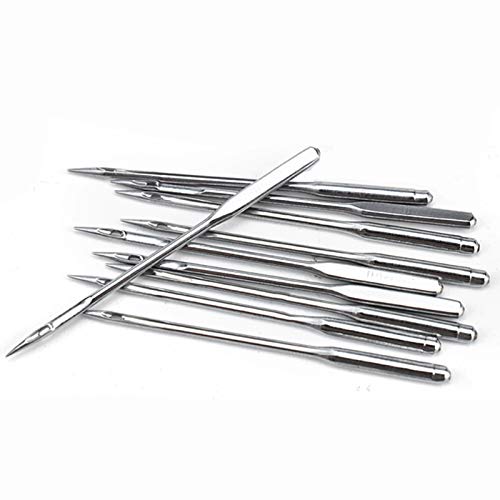 Flat needles have a uniquely flat, almost teardrop-shaped body. The triangular tip has a sharp point and the eye often has two small holes divided by a central bar.
Flat needles have a uniquely flat, almost teardrop-shaped body. The triangular tip has a sharp point and the eye often has two small holes divided by a central bar.
You use this specialty needle primarily for working with plate metallic thread, which you sometimes use for couching embroidery work.
Basically, you use a tiny flat strip of metal as if it was a ribbon and work it into the design!
11. Heavy Duty
 Heavy-duty sewing needles usually come in small-number sizes like 1-5, which feature a much wider diameter than medium or small needles. You can use heavy-duty needles for all kinds of projects, ranging from sailmaking and repair to upholstery to tapestry embroidery or leather working!
Heavy-duty sewing needles usually come in small-number sizes like 1-5, which feature a much wider diameter than medium or small needles. You can use heavy-duty needles for all kinds of projects, ranging from sailmaking and repair to upholstery to tapestry embroidery or leather working!
Depending on the style of heavy-duty needle you need, you may see the size listed as the diameter of the needle or as the length of the needle. You can even buy a pack of heavy-duty needles to have on hand for multipurpose use if you prefer!
12. Leather
 The easiest way to sew leather by hand is to use the appropriate leather working needles, such as glover’s needles, which have a heavy-duty size, a sharp point, and a wide eye to fit the leather thread. You can also get another type of leather-working needle, such as leather lacing needles with two prongs and help with things like putting in the lacing on a baseball mitt.
The easiest way to sew leather by hand is to use the appropriate leather working needles, such as glover’s needles, which have a heavy-duty size, a sharp point, and a wide eye to fit the leather thread. You can also get another type of leather-working needle, such as leather lacing needles with two prongs and help with things like putting in the lacing on a baseball mitt.
Depending on the thickness of the leather you want to use, you often need a full kit of tools, including an awl, to complete a leather sewing project. The needle alone often is not enough.
13. Milliner’s
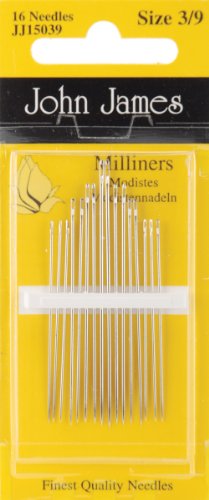 Milliner’s needles have an extra-long shaft, a fine eye, and a sharp point.
Milliner’s needles have an extra-long shaft, a fine eye, and a sharp point.
These characteristics make them perfect for gathering, basting, or making bullion embroidery knots by hand.
Sometimes you still see these long sharps referred to as “straw” needles because milliners used to use them to sew through straw hats!
14. Sashiko
 Sashiko needles have a long, heavy-duty shaft and a wide eye for the thick cotton thread used in this sewing method.
Sashiko needles have a long, heavy-duty shaft and a wide eye for the thick cotton thread used in this sewing method.
You need a longer needle for this special method of embroidery/mending that involves forming repeating rows of the same kind of stitch.
This traditional Japanese method of embroidery makes beautiful patches to cover up holes in clothing or decorate quilts!
15. Sharps
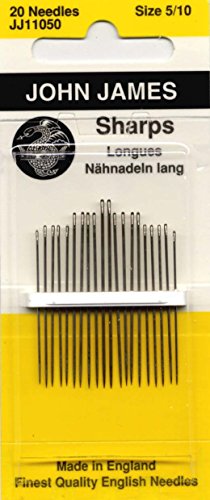 The term “sharps” encompasses all needles that have sharp points rather than ballpoint or diamond-shaped points. You can also find these needles called general-purpose or standard sewing needles.
The term “sharps” encompasses all needles that have sharp points rather than ballpoint or diamond-shaped points. You can also find these needles called general-purpose or standard sewing needles.
This type of needle is the most popular tool for dozens of different kinds of sewing and is what you will find in most store-bought sewing kits for that reason.
Sharps can range in size from 1 to 12. Sharp needles sized 6-9 have a fine, slender body and a small round eye. You can use these for sewing on a light or medium-weight fabric, and this is often the needle of choice for simple home sewing projects or even for completing couture dressmaking details.
16. Tapestry
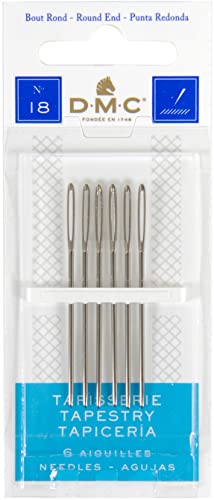 A tapestry needle has a large eye to fit embroidery floss or yarn and a blunt tip to easily pass through cloth with large-woven fabric, such as Aida cross stitch fabric or some types of cotton or linen. The ballpoint tip allows the needle to slot through each square in the weave, forming neat, even stitches.
A tapestry needle has a large eye to fit embroidery floss or yarn and a blunt tip to easily pass through cloth with large-woven fabric, such as Aida cross stitch fabric or some types of cotton or linen. The ballpoint tip allows the needle to slot through each square in the weave, forming neat, even stitches.
While many tapestry needles, like the ones used for cross stitch, have short shafts to allow more control, you can find several different styles of tapestry needles. Curved tapestry needles form the shape of the letter “C.” This kind of needle works especially well when embroidering on a stiff surface like punched paper.
Bent-tip tapestry needles have a hooked tip, and this kind of needle works well with yarn knitting and crocheting projects as a tool to finish the edges.
17. Quilting
 Traditional quilting needles, also called a “between” or a “short,” have the same shape as a regular sharp but with a much shorter shaft.
Traditional quilting needles, also called a “between” or a “short,” have the same shape as a regular sharp but with a much shorter shaft.
The fine, short form of this needle allows a hand quilter to make quick, evenly-spaced stitches across the surface of the quilt.
Modern quilters also regularly use milliners or sashiko needles for quilting, especially for larger or more decorative stitches.
18. Upholstery
 Upholstery needles come in a range of different lengths and heavy-duty diameters. They can also have either a straight shaft or a curved shaft. They have sharp tips and fairly large eyes to accommodate thick thread. Some upholstery needles may measure as long as six inches, though many have a more traditional two or three-inch length.
Upholstery needles come in a range of different lengths and heavy-duty diameters. They can also have either a straight shaft or a curved shaft. They have sharp tips and fairly large eyes to accommodate thick thread. Some upholstery needles may measure as long as six inches, though many have a more traditional two or three-inch length.
These needles can sew through multiple layers of thick upholstery fabric. Curved upholstery needles work great when stitching piping onto an edge or corner of a couch or chair.
Hand Sewing Needle Sizes
Hand-sewing needle sizes measure the diameter of the needle shaft. Smaller numbers indicate larger needles, while larger numbers indicate finer, thinner needles.
Sizing for hand-sewing needles is based on the diameter of the needle, not on its length. That said, different kinds of needles can use different diameter measurements for their sizing. For example, a size 1 tapestry needle may look considerably larger than a size 1 sharp.
If you ever need more details about a particular needle, you can look it up on Amazon and read the product description. This should list its precise diameter in millimeters, as well as its length and intended purpose.
Hand Sewing Needle Size Chart
This chart will give you a general overview of the sizes available for the most popular types of hand-sewing needles.
| Type of Needle | Size | Length | Uses |
|---|---|---|---|
| Ballpoint | 5-10 | Varies | Knit fabrics, cross stitch |
| Beading | 10-15 | Varies, often two to three inches | Adding beads to woven beadwork or embroidery containing beads or sequins |
| Bodkins | Usually one-size-fits-all | 4-6 cm | Inserting elastic or cording into a fabric casing |
| Crewel | 1-12, 6-8 most common | Varies | Many types of embroidery, including surface embroidery, whitework, blackwork, and cutwork |
| Chenille | 14-28,18-24 most common | Varies, smaller size numbers like 14 quite long | Embroidering with chenille yarn, or doing any type of tapestry work or crewel work |
| Darners | 13-26, 16-26 most popular | Always long, but “Long” darners may measure five inches or more | Mending holes by weaving new threads in a plain-weave structure over the gap |
| Doll | Measured by length | 3.5” to 7” | Jointing parts of soft toys like dolls together, or embroidering details and features onto the toys |
| Easy Threading | Varies | Varies | Allows people with sight or mobility difficulty to slot the thread into the needle from the top or side |
| Felting | 32-40 gauge | Varies, often has a handle | The barbed tips catch on wool, turning it into matted felt |
| Flat | Varies | Varies | Adding strips of metal to embroidery |
| Heavy Duty | Varies but always large diameter | Varies but usually longer than average | Stitching through canvas, leather, upholstery material, denim, or other heavy-weight fabrics |
| Leather | 1-12 | Varies | Stitching through leather |
| Milliners | 1-10 | Up to 7” long | Basting, gathering, sewing straw hats |
| Sashiko | Varies | At least 2 inches, can get much longer | Stitching traditional repeating patterns in Japanese mending technique |
| Sharps | 1-12, most popular 6-9 | Varies | Sewing any light or medium weight fabric |
| Tapestry | 13-28 | Length and shape can vary, including curved or bent-tip style | Sewing upholstery fabric, tapestry canvas, and some types of embroidery |
| Quilting | 3-12, 8 and 9 most popular | Quite short, also called “betweens.” | Hand quilting through layers of fabric and batting |
| Upholstery | 3-18 | Varies, comes in different styles such as curved as well | Sewing through upholstery fabric and fixing fabric to furniture |
What Needles are Best for Beginners?
The most useful all-purpose needle for beginners is a sharp needle, which has many applications, such as sewing on a button, performing any stitching, or mending on light to medium-weight cloth. Sharps serve the same purpose for hand sewing as Universal needles do on a sewing machine–you can use them for almost everything!
Check out a few more tips for choosing the best needle as a beginner sewer:
- Always select a needle that will match the fabric you need to sew. Then pick a thread that fits the needle eye comfortably.
- If you can, choose a mid-sized needle. Working with very fine needles can prove challenging as a beginner, while a needle with an average diameter will fit your hand more easily.
- Use a needle threader! Whether you want to sew with embroidery thread, crewel yarn, or waxed buttonhole thread, you will find the process much simpler if you get off on the right foot by easily threading the needle.
- Buy a new needle each time you begin a new project. Needles do not cost much, and sewing with a properly sharp needle will make your life much easier.
What Needles are Best for Hand Sewing?
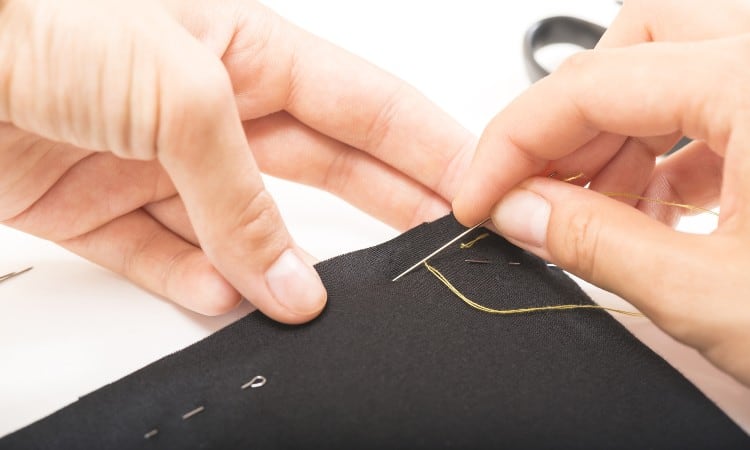
The best needles for hand sewing depend on the style of sewing because quilting, embroidery, and upholstery all require different styles of needles. Overall, the best multi-purpose hand-sewing needle is a mid-gauge sharp. But your best bet for getting the right needle for the job is to pick a needle designed for a specific type of sewing.
The type of hand sewing can dictate what shape of needle you should use, such as whether you need a needle with a large eye or a fine eye. For example, crewel work often needs a needle with a larger eye that can hold yarn, but beading quires a tiny eye so it can fit through the center of a bead!
The type of fabric you want to sew through will also help you choose a needle. If you try to sew through heavy-weight fabric like denim or canvas with a fine-gauged needle, the needle will bend or even snap. Instead, heavyweight fabrics require heavy-duty needles like tapestry or upholstery needles.
The weave of the fabric also matters, though, as ballpoint needles work best in knit fabrics and sharps work best in plain-weave fabrics.
The bottom line is that you should start by picking the type of needle designed for your particular field of sewing, such as a crewel, quilting, or upholstery needle. Then select a size of needle based on the weight of the fabric you want to stitch through, and you should be good to go!
Conclusion
Hand-sewing needles come in many different styles based on the kind of sewing technique, such as quilting, embroidery, cross stitching, or doll joinery. Each style of needle has variations in the shape of the eye, the length of the shaft, and the shape of the point. Some needles, like flats and bodkins, have non-linear shapes, and needles, such as tapestry and upholstery needles, sometimes have a curved shape.
Needle sizes depend on the gauge, or diameter, of the shaft. These sizes can range from 1 to 40, with larger numbers indicating a smaller diameter and smaller numbers meaning a larger diameter. This means a size 1 upholstery needle will look much bigger than a size 6 upholstery needle.